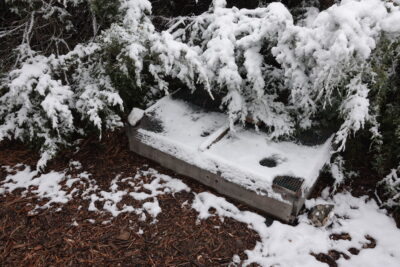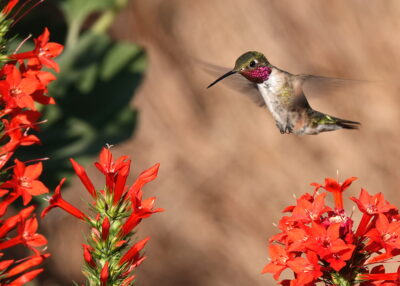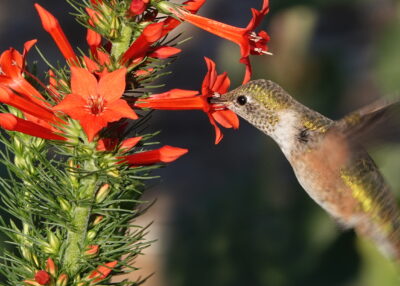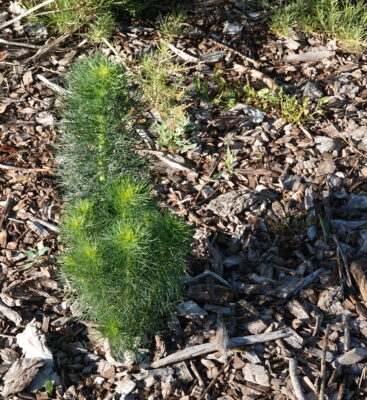An Interview with Member Doug Swartz
by Caitlin Marshall
We love getting to hear from our members, and we thought you might like to hear from each other, too! Here’s Doug Swartz, an enthusiastic gardener, birder and Wild Seed Project supporter. Doug is not the typical Northeastern Wild Seed Project member – he lives way out in Colorado, and so the species he works with are different. But as his many successes show, the methods of growing native plants from seed can work in a variety of ecoregions.
How did you find Wild Seed Project?
Well, I think my story is probably common with a number of your folks. I read about it in the New York Times (gift link) in the fall, maybe two or three years ago. I just happened to stumble across the article and it was great and very relevant to stuff I was interested in. I read it and followed up and here I am.
A question I’ve been asking other folks is, tell me about one of the first times that you grew plants with our seeds – but my understanding is mostly you haven’t used our seeds. Right, I haven’t used your seeds. I’ll give you a little backstory. I live in a co-housing community […] One of the first things we laid out was a natural area as part of the site plan.

The setting includes the non-native, highly competitive pasture grass (Smooth Brome – a challenge for restoration throughout a good chunk of the West) that we inherited.

We have developed many “islands” within the Smooth Brome as well as extensive planting on the perimeter to slowly shrink the area of non-native grass. Here is the perimeter path passing through a mixed thicket with a highly diverse combo of large trees, shrubs, forbs and a small number of native grasses.
We had this grand vision of restoring the ecosystem – and zero knowledge. So we have learned everything that we know out there was learning by doing. Experimenting, making mistakes. Starting five or six years ago, I’ve been trying to get some more wildflowers in there. I started collecting seeds and scattering seeds in the fall. And having almost no success with germination.
So then it must have been 2021. I tried some indoor starts with seeds and had reasonable success. And then that fall, I found out about Wild Seed Project. I saw, oh, I think there might be a much easier way to do this. And there’s other people who know how to do this. Here’s a good chance to learn. That year I planted seeds using the winter sowing Wild Seed Project technique. Now I’m on year three of that.

I typically plant seeds in small pots ~Jan 1. Off to a full shade area where nature primes them.

A late April snow

We see first germination from early species typically early April; this gradually continues with some warm-season species not sprouting until mid-May.

Gradually, as germination proceeds and the plants put on a little growth, I move them from winter shade to partial sun on the edge of the windbreak. They’re ready to pot up to 1-gal late May/early June.
You said you finally had some successes. What is something that’s felt like a success, or that you’ve been excited about?
Well, one of the ways I see success on this natural area project is I’m a birder. I’ve had the great fortune to be able to observe birds here since the farm field days – what we moved into was an old corn field, with very low bird diversity and numbers.
And over time, I have seen the response to habitat restoration. I mean, it’s made me a total believer in the value of this stuff. And along the way, as we’ve built our habitat, I’ve gotten to learn not only about birds, but also the plants and the insects and the ecosystem that makes it all work.


Hummingbirds visiting Ipomopsis rubra flowers
I do a bird loop on our property almost every day. And so I have good records on that. And it’s just so cool: Every year, we get a couple more species. We’re up to somewhere like 155 species. Way, way, way higher than where we started. It’s so rewarding. Of course, we’re seeing the same increase with pollinators and other insects.

A bee hiding in in wild bee balm. As part of my growing awareness and understanding of nature through this project, my appreciation for pollinators has grown. It wasn’t until I began to take photos that I discovered it could be hard to take a picture without finding a pollinator in the field! It’s not uncommon that I only notice them when I download and process the image and see antennae poking out or a couple of eyes or the tail end of a well-camouflaged beetle.
For me, birds were the initial hook for taking on this project. And then over time, this led me to plants, insects, interactions, ecology / ecosystem thinking. Watching an ever-growing suite of organisms using the habitat we’ve provided warms my heart and motivates me. This works! Nature is incredible! And the more one learns, the more one wants to learn. 🙂
What is a time when you’ve been surprised as you’ve been going through this process of learning?
Let’s see, surprise. Well, probably shouldn’t be surprised, but just the diversity of native plants is remarkable. And, growing your own from seed can provides more opportunities to diversify and experiment. In Fall 2022, I was hoping to find some Ipomopsis aggregata seeds at a native seed swap. A very dry and tough plant, great for hummingbirds. Didn’t succeed but was able to get just a small number of I. rubra seeds. This is a species I wasn’t familiar with. Planted early winter 2023, had low germination and ended up being able to plant out just three sparse clusters. This is a biennial and last summer grew as a low rosette with quite different foliage than I’d expected. Early this season, it looked about the same . . . for a while.
Then in early June the action began as it slowly started to put on some vertical growth. By late June, we were looking at 6″ to 18″ spikes that were quite surprising – VERY different from I. aggregata, the species I’d originally sought – and had us talking about Dr. Seuss!

Then in August, spectacular flowers. And the hummingbirds. Wow, what a show! Seed pods, also very cool, quickly developed and are still ripening; we are keeping track of them to collect when ready, as this is a species now on our “must have” list. And that we wouldn’t have experienced without the chance opportunity to grow them from seed.


(Footnote: turns out this is a “near native” with a range from the SE U.S. as far N and W as Oklahoma. Though we aim for local natives as much as possible, we are willing to be a bit liberal in defining our circle. With climate change, species like these are moving toward us on their own.)
Is there anything else that you wanted to share?
Well, I thought you were probably going to ask me what I most value from Wild Seed Project. What I value particularly about Wild Seed Project is the monthly Q & A. Your staff are amazing. In terms of their knowledge, depth of knowledge, their depth of experience and their ability to answer questions in a way that works for people like us, like me, who don’t have nearly as much experience, but are eager to learn.
That’s what I get the most out of, along with learning some of these techniques from articles. I get to ask my questions and get answers. And also listen to all the other questions that are being asked, and learn from those. Everything’s conveyed in such a professional, friendly way.
Thank you so much for sharing, Doug! We’re lucky to have you in our community.
All images (c) Doug Swartz.

